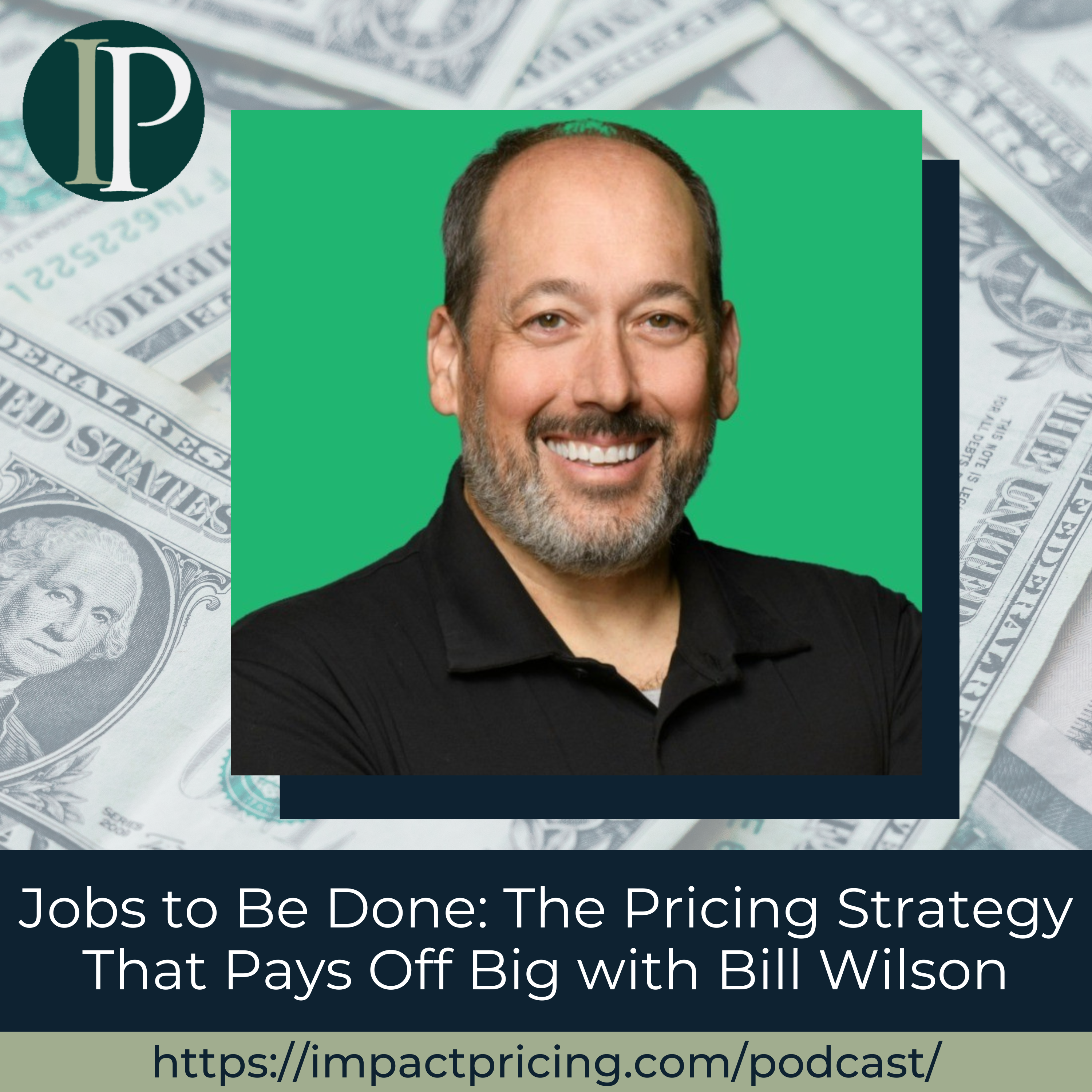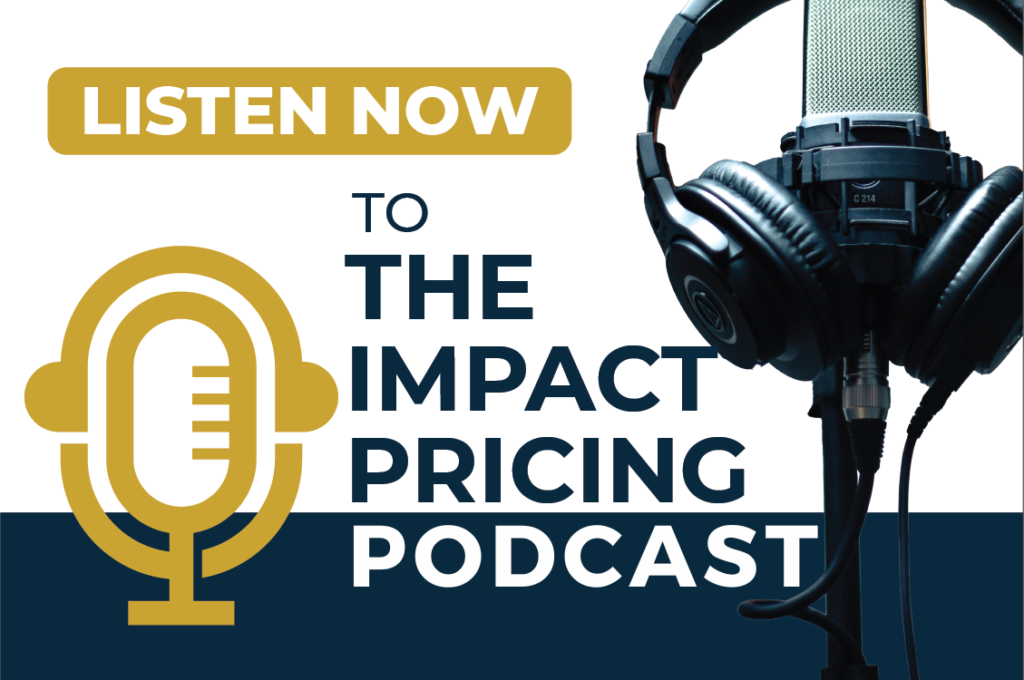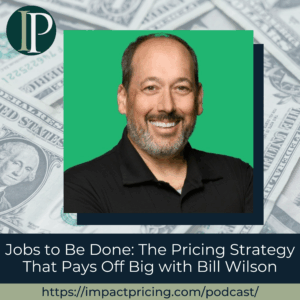
In this episode, Mark and Bill dive into why the Jobs to Be Done framework offers a more effective lens than traditional problem-and-results approaches, leading to insights about value realization, emotional jobs, and why the biggest pricing advice might be the simplest: just raise your prices.
Podcast: Play in new window | Download
Why you have to check out today’s podcast:
- Learn the critical role of value realization and how to effectively package products to help customers achieve desired outcomes quickly and sustainably.
- Understand the Jobs to Be Done framework, how it differs from traditional problem-solving approaches, and why it’s vital for grasping true customer motivations.
- Discover practical pricing strategies, including overcoming fears around raising prices and how thoughtful price increases positively impact a company’s bottom line.
“Without being too on the nose about it, you probably should raise your prices.“
– Bill Wilson
Topics Covered:
01:32 – Bill’s journey from technical founder in 2007 to productizing services, escaping hourly billing, and discovering that pricing is everyone’s delicate secret.
06:59 – The Product-Pricing-Positioning Triangle Why these three cannot be separated: value delivery (product), value perception (positioning), and value capture (pricing).
09:33 – What is Jobs to be Done? Bill’s definition: statements describing the progress customers are trying to make, with specific ways to measure that value.
14:17 – The Trigger Moment: Status Quo Change Why the sandwich shop example illustrates how triggers create jobs people are willing to pay to solve, unlike generic problems.
20:11 – Context-Driven Pricing Meets Jobs to be Done Mark’s framework of foundational problems, problem scope, and situational context—and how it maps to Bill’s JTBD structure.
21:56 – System 1 vs. System 2: Emotion vs. Value Separating intuitive, emotional buying (System 1) from deliberative value calculation (System 2)—and why B2B sellers must address both.
26:39 – The Three Phases of Value Value perception (positioning), value realization (first aha moment), and value adoption (features driving continuous use).
30:08 – The Product-Pricing-Positioning Connection in Practice: Why Bill sometimes produces product requirements documents during pricing engagements—because time-to-value affects pricing success.
30:28 – Final Advice: Raise Your Prices The simplest, most powerful advice that everyone fears—and why money from price increases falls directly to the bottom line.
Key Takeaways:
“A job to be done inherently has monetization built into it because there are a lot of problems that I’m not willing to pay to be solved. But a job in and of itself is something I’m actively trying to achieve.” – Bill Wilson
“Recurring revenue lives in value adoption, not in value realization. I can get anybody to realize value pretty quickly and they’ll never buy my product more than once.” – Bill Wilson
“Everybody’s scared to death to raise their prices. But if you haven’t raised your prices in a couple of years, you’re probably safe to raise your prices. And all that money that you raise it by, whatever percentage that is, is going to fall directly to the bottom line.” – Bill Wilson
Resources and People Mentioned:
- April Dunford: Positioning expert, author of “Obviously Awesome” and “Sales Pitch”
- Anthony Ulwick: Outcome-Driven Innovation approach to Jobs to be Done
- Clayton Christensen: Jobs to be Done theory pioneer
- Danny Kahneman: System 1 and System 2 thinking framework
- SaaS Academy: Where Bill coaches companies on pricing
- Volta: Coaching organization Bill works with
Connect with Bill Wilson:
- Pace Pricing: https://www.pacepricing.com/
- LinkedIn: https://www.linkedin.com/in/wdrwilson/
Connect with Mark Stiving:
- LinkedIn: https://www.linkedin.com/in/stiving/
- Email: [email protected]
Full Interview Transcript
(Note: This transcript was created with an AI transcription service. Please forgive any transcription or grammatical errors. We probably sounded better in real life.)
Bill Wilson
Well, without being too, you know, on the nose about it, you probably should raise your prices.
[Intro / Ad]
Mark Stiving
Welcome to Impact Pricing, the podcast where we discuss pricing, value, and the sales-driven relationship between them. I’m Mark Stiving, and I run boot camps to help companies get paid more. Our guest today is Bill Wilson. Here are three things you want to know about Bill before we start.
He is the CEO and founder of Pace Pricing, a pricing consulting firm. He’s coached many companies through the SaaS Academy. And my favorite thing, I’m totally jealous about this, he is the official pricing advisor for the government of New Zealand. I want that job. Welcome Bill.
Bill Wilson
Thanks so much. I’m thrilled to be here again. This is going to be great.
Mark Stiving
Yeah, you were here in 2019. I guess you’ve learned a few things since then.
Bill Wilson
One or two, I may have changed my, I may have learned a few things along the way, for sure. While I was running that startup, we focused on pricing for SaaS companies and now into the consulting space, it’s lots of learning.
Mark Stiving
So, one of the best things about being a consultant is you get to see so many different companies, situations, et cetera. So it really expands your view of what pricing is and how it works. But let’s jump back to the beginning. How did you get into pricing?
Bill Wilson
Yeah, so I’m a software developer by trade. That’s where I come from. So my journey to pricing was a bit weird. I founded my first company in 2007, and we built products for other people. And I was doing that kind of like, you know, from a very technical perspective. But at that time, I also started productizing our service.
And I had to come up with a way to sell that productized service in such a way to get out from underneath selling by the hour, because we all know that kind of sucks. And so we created kind of a good, better, best style pricing architecture, stealing a page from the B2B SaaS folks. And we built a small tool to help us actually push that out to our clients.
So anyway, we heard enough from our clients about, hey, this is a really, really cool tool. Where do you get it? Because we were selling to a lot of B2B SaaS companies ourselves. And that’s when I realized we should go build something to help support B2B SaaS companies around pricing, at least from a quoting perspective.
And that forced me to go very, very deep on pricing and really understand all the different models and things like that. So at that time we were, as I was selling, I was also doing a lot of consulting on these sales calls because people would inherently ask me, what do you think about our pricing? They would always ask that question. Do you think it’s good?
You see lots of pricing. What do you think? And I realized, there was this weird thing that floats around pricing. It’s a really delicate topic, it seems, and nobody really wants to own it. And that’s what really got me excited about trying to help. And once we were acquired in 2020, I spent all my time since just helping B2B SaaS companies figure out their pricing and packaging and positioning.
Mark Stiving
Nice. What a great story. And so, you’re a geek. I’m a geek. You know, I was actually an electrical engineer a long, long, long time ago. Not that I remember anything, but what I think is really cool and attractive about pricing is we jump into it thinking, oh my God, it’s quantitative. It’s a number. Isn’t that really cool? And then we had this brief conversation before we hit the record button. And it’s actually about value, right? It’s about something very different. So when did you realize it wasn’t about the number?
Bill Wilson
It’s interesting, I think as part of my coaching at places like SAS Academy and Volta and a few others, I wasn’t only, like the pricing questions would always turn into other types of questions. You know, people would show up and go, I have a question about pricing, but what they really had a question about was positioning or the product itself or some of these types of things.
So it took me a while to get to the point where I’m like, yep, it’s all we can do. We can go off and do surveys and get quantitative data and get really confident in our data. And the big thing I learned was that, because to me, I was like, look, if we can get the data and be really, really confident in the data, it’s going to work. What’s the problem? Let’s do this. Let’s roll these pricing changes out.
But it wasn’t until a little later on that we’d go through these processes and have really great outcomes. And then the teams would still be scared to death to get it out in front of their customers. And so, that’s when I realized there were two things happening. One, there’s a value connection piece that was kind of missing. And I’ve always talked about value, but it didn’t put it as far in the forefront as I should have.
And then I guess secondarily, it’s this idea that data doesn’t necessarily breed confidence, right? What breeds confidence is a value understanding that is shared across the organization. So if you can all look at value in the same kind of lens, then you’ll be much more confident as you go to roll out any kind of changes.
And so, that’s what sort of really led me to believe like, you know, a layer on top of sort of value based pricing is that the value lens across the organization has to be understood because pricing impacts every single division of your company and they all perceive it differently and they all have their own wants and desires and needs and we have to address that. So, it’s almost like a change management process. And that’s where the value came in.
Mark Stiving
Yeah. And in the exact same way, every department in the company affects the value we deliver to our customers. So it, and I used to use this phrase a lot. I rarely use it anymore, but that is you don’t have a pricing problem. You have a value problem.
Bill Wilson
Yeah, absolutely. Yeah. And so for me, I realized there’s kind of three things that also feed into that. So there’s the pricing itself, which to me is kind of like the packaging and the offer and the price points, but then there’s the positioning and then there’s the product itself. And so those three things are all about value, right? So the value delivery, which is your product, right?
That’s how you deliver value to your customers. There’s the value perception, which is how you position and present yourself to the world. And then there’s the value capture. And that’s how we price. And so those three things, I don’t think you can change one without changing the others. I think they all, it’s like a triangle. They’re all connected product pricing and positioning. They all connect together.
And so, that even takes that value conversation even further because now we’re, we’re getting into the weeds and, and helping them with, you know, understanding where product goes and how to position themselves in the market. And yeah, it’s really fascinating once you get into the value side of a business.
Mark Stiving
Yeah. And by the way, I agree with everything you just said. There was one piece that I’m sure that you have bundled into those three that you just talked about, but it didn’t stand out to me. And that is salespeople selling value, being able to communicate the value that we’re actually delivering to a specific buyer in any situation.
Bill Wilson
Yeah, a hundred percent that whole value perception and positioning, because the positioning has to feed directly into your sales pitch. Especially if we listen to our really good friend, you know, April Dunford, right. Obviously awesome. And then her next book is sales pitch.
So it’s like, how do you take your positioning and then now turn it into something that your sales team can actually communicate. And I think 100% of all of those things. And, you know, especially those frontline folks, customer success and sales. They are the stewards of your value proposition in the market and they have to really be able to communicate it and believe it. That’s the other thing, conviction.
Mark Stiving
Nice. Okay, so, so far we’ve been nice to each other. Let’s get into it. So I ask all my guests, what is it that you’re passionate about? What do you want to talk about? And Bill wrote Jobs to be Done. I love using Jobs to be Done. And if you’ve been listening or reading me lately, you know that I’m not a fan of Jobs to be Done. So I’m going to give Bill a chance to convince me that I am totally missing the boat on this. So let’s start. What the heck is Jobs to be Done, Bill? Let’s start from the beginning.
Bill Wilson
Sure. So the way I look at Jobs to be Done, I like, you know, Anthony Ulrich’s sort of innovation design, outcome driven innovation approach. And I also like, you know, Clayton Christensen’s approach to jobs to be done. That’s like, we take a bit from both of these things. So from my perspective, customers are trying to make progress on something in their life.
And so, I look at jobs as progress. The functional jobs are in there, but jobs as progress is probably the most important thing. So once I can get a framing around what progress a customer is trying to make, it makes my packaging job a lot easier. And it does that because the job to be done can highlight a ton of things around, you know, mismatched value and all these kinds of things.
But to answer your question, what is jobs to be done? So to me, it is a set of statements that describe the progress a customer is trying to make with very specific ways about how to measure that value that they’re trying to achieve across those things.
Mark Stiving
Okay, so let me tell you what I don’t like about it. By the way, I’m not anal about this. It’s totally okay to be wrong. But here’s what I don’t like about it. First off, it’s not natural to me, as in, I have to step back and think, what does jobs to be done actually mean? And the other thing is, I’ve never seen a jobs to be done that I couldn’t explain using problems and results. And so I talk about problems and results all the time, and those feel very natural to me.
Bill Wilson
Well, my counter to that is this. I used to think in terms of problems and outcomes and all that kind of stuff, too. Like, you know, hey, what pain do they have? What are we trying to solve here? All that kind of stuff. I think the nice thing about jobs to be done is it inherently has monetization built into it because there are a lot of problems that I’m not willing to pay to be solved. But a job in and of itself is something I’m actively trying to achieve.
And I’m either going to hire something, someone, or, you know, otherwise trying to do it myself, those jobs. So that to me was the big differentiation piece from just talking about sort of problems in general and getting very much more specific about, okay, there’s an executor of this job. They’re trying to get this done and they’re willing to pay for it. It’s built into the fact that it’s a job. And that’s why I look at it. So you’re right. You can describe all of these things with problems. A hundred percent.
You could describe any job to be done as a problem statement. No problem. But the nice thing is, is that there’s a job to be done, but if you think about the job to be done as sort of a specific way of talking about a problem statement, and then think about the trigger point, which is the status quo change that’s happened in their life, such that this now has to be hired for. And that, that is the key.
That’s the connection point for me between where it’s different between just problems and outcomes. It’s like there’s the trigger, which means that there’s a job I need to get done. And then I’m trying to make progress on that job. So my simple example is, you know, I’ve got a meeting at three o’clock, I’m walking down the street and all of a sudden I’m absolutely starving, I forgot to eat lunch. And now my status quo changes that I’m starving.
And now all the things that feed into that, my emotional and social jobs and all the rest of these things are like, well, I’ve got a meeting at three o’clock. I can’t show up, you know, tired after eating a big meal. I need something light. Like all these sorts of specifications start spinning in your head. You’re not thinking I have a job to be done. You’re just like, I need to get a sandwich. And so, the trigger is I’m hungry.
All the things that feed into it are all your circumstance and all of those types of things. Those emotional and social pieces that you have to deal with, and of course the functional job of actually eating something. And so you come across a sandwich shop, you buy the sandwich, that sandwich was hired to solve my job to be done.
And so, I know customers don’t think about that. They don’t think about those things. But if we can get really clear internally about why people buy, which is that trigger moment, and then what they’re trying to accomplish, what progress they’re trying to make, I think it goes a lot further semantically than just talking about problems and outcomes. And so, I think really, you’re not wrong, but.
Mark Stiving
Okay, so let me try to share how I think about this. And I’ve been doing a lot of research and writing now on a topic I call context-driven pricing. And context-driven pricing essentially says, you know, hey, I’m walking down the street and I have a three o’clock meeting and I’m starving. What’s the context of the situation? So, you know, there’s a lot going on here in terms of that context.
But when I think about the different contexts that we could be dealing with, two of those are problems, and one of those is situational or environmental context. So the two that I think of are problems. One is what I call the foundational problem. So sometimes when I think about jobs to be done, I try to equate my foundational problem with jobs to be done, right? Why is it that I’m buying something in this product category? The next layer down is the problem scope, right?
So give me details of the problem so that I can help determine which solution is the best for me as a buyer. I often use Uber as an example for this. And when I think about, I’m going to say the words jobs to be done. When I think about foundational problems, I think about, I as a person need a ride. So that’s one foundational problem. I need McDonald’s delivered to my house. That’s a second foundational problem. Or I want to deliver Amazon packages.
Turns out those are three different market segments that Uber uses. And I think of those as foundational problems. Let’s just look at Uber people for a second. And when you jump down into Uber, I’ve got UberX, UberXL, UberRideshare, UberSki, and each one of those are designed because they’re solving specific problem scopes underneath the umbrella of, I need a ride. Okay, tell me how that fits in jobs to be done. For sure.
Bill Wilson
Yeah, so there’s an overarching functional job to be done that you’re talking about, which is basically someone needs to go from point A to point B. So for me, as someone who’s going to use Uber in that people category, is that I just need to go somewhere. And you’re right, I do have a lot of context around that. There’s a bunch of things that feed into it, and that’s sort of the emotional and social pieces of the functional job to be done.
So the functional job to be done is I need to go from point A to point B. And this is just one of the ways I could hire something to do that. I could drive myself, I could have a friend drive me, I could use Uber, I could take a taxi. So there’s lots of different ways. So the nice thing about jobs to be done is they’re agnostic of technology.
Mark Stiving
By the way, so is a well-written problem statement. 100%.
Bill Wilson
I mean, I think what we’re going to find out here is, we’re talking about, you know, it’s very, very similar views on this stuff, just through different languages. So you were talking, and there’s Uber XL, there’s, you know, Ski, all these different things. And so that’s the context. So those are the sub jobs that need to get done underneath the main functional job.
So just like you were saying, it’s like, there’s still functional jobs. I need to take my skis with me. Like I need to transport skis. That’s my sub, my functional job there. So that’s how I would describe all of those. All of those are functional jobs. The fact that I want to get there safely. The fact that I want to be comfortable. The fact that I want to show up in a black limousine and look cool is a social job. Like those are all the other contexts that touch the softer side of what’s actually happening and do really inform why people buy.
The social and emotional jobs we can’t discount. Because at the end of the day, in B2B, we are selling to people that happen to work inside organizations. But they’re still people, and they still have desires, and they still have, you know, social pressures. They still have all these things. So we have to consider those as we go through our journey. So that’s, to me, that’s how it all fits into your Uber example. How does that feel?
Mark Stiving
Beautiful. Here’s the thing. I didn’t need jobs to be done. Right. So, I’m back to the issue that says, look, I don’t, I don’t hate jobs to be done. I don’t find that I need it to do what I do. And it bugs me because so many people love jobs to be done. That’s what really bugs me about this.
Bill Wilson
I think it’s a, you’re right. I mean, we can, we can just say, yeah, it’s a problem and we have to have context and let’s go solve those problems. I think the nice thing about the jobs to be done is that it highlights, it has a structure already around it that helps you not try and keep an NP complete problem in your head, you know, like trying to like, you know, there’s so many variables, right?
So it helps you categorize the different pieces, because there’s value drivers on top of this, right? So these are the emotional, social jobs, but what are the value drivers? How do I measure my outcome, right? I want to minimize my time to do this. Those are all the outcomes I’m after. So those are the value drivers.
So having common language I think is really, and it needs to be a bit more granular, I think, than, you know, problem and context. I think it’s like the type of context matters. And then being able to measure, have we achieved, have we solved all of these jobs to be done through whatever packaging structure we’ve built? So we can use them as a litmus test.
Like, do we have the value drivers? Is it driving the value? Is it delivering on those things? Is it delivering on the emotional jobs? Is it delivering on the functional job? So to me, that’s why I use it. It’s a very clear way of articulating value across the organization. And if they can adopt that, then everybody will have the same kind of lens. But talking about problems and context, I feel like it’s just, you’re not wrong. I just think it’s a layer above. I think it’s almost too abstract.
Mark Stiving
Okay. Just to be clear, though, I talk about problems and results. Context is the world in which it all exists, right? So when I think of results in the world of B2B, results are KPIs. Right. What’s a KPI I’m going to move from my client that doesn’t account for the emotional results. I’m with you on that.
Bill Wilson
But that’s the job. See, that’s, that’s what the company’s trying to achieve. That’s how they measure. Right. But from a customer’s perspective, right. It might be a KPI for them too, but there’s things that like we’re trying to measure, like the ultimate thing would be trying to find metrics that line up in both businesses, such that if we measure them, if you’re already measuring and I’m already measuring it and we can make it go up for you and it goes up for us, then that’s great.
But yeah, I think, yeah, KPIs, I guess could be outcomes. I think it’s one facet of an outcome for sure. Maybe I’m thinking about KPIs way too deep, like way too like specifically, but I think there’s, like you said, it doesn’t capture necessarily the emotional and social measurement, which is, you know, granted to be difficult to measure.
Mark Stiving
I’m totally with you. Well, so I was, you know, if I wanted to push back, I’d say, well, how do you measure those results and jobs to be done? And I get it. You can’t, so it’s not a huge deal. Okay. By the way, you haven’t convinced me, but I don’t hate it. So it’s like, okay.
Bill Wilson
I mean, you know, it’s taken me quite a while to come this way, you know, like I used to just focus only on the functional job and, you know, where there’s other pricing folks in the world and I highly respect them that are very much like one package for one functional job and I get it, you know, and I’ve done that. But the more and more I dig into it, it’s the trigger moments. And are we satisfying those? Do we feel like these will satisfy those emotional and social jobs?
The functional job, if you’re not solving the functional job, like that’s a whole, like, you know, we have to, table stakes is you’re solving the functional job. How well you solve that functional job is also, you know, is where competition comes in. But the other pieces I think about why people buy is the stuff that I think really helps people stop thinking about, especially in B2B SaaS, people are like, okay, cool.
What should we put in our base package? And they start thinking, what features do we need? And that’s the wrong question, right? We should be thinking about what are we trying to make progress on and how can we design a package that really actually delivers on that progress. And so if we can change the frame of the way people think about pricing internally to be centered around value and jobs to be done just being another way to talk about value, then I think our job is done.
I’ve been through several pricing engagements where one of the biggest takeaways for the organization was, they were like, we love what you taught us about how to think about value and that’s going to inform everything we do from going forward. And to me, like that’s, that’s perfect. You know, I love that. Yeah.
Mark Stiving
Nice. There’s two different directions I want to take the conversation based on what you just said, but I’m going to pick one. And I want to talk about value versus – I’m going to say value versus emotion. And so if you think about Danny Kahneman’s System 1 and System 2 thinking, So system one thinking is very intuitive, fast reaction. I would put emotion there. I would put most behavioral economics that we do fits in that category.
And then, I would say the other side, system two thinking is I’m deliberatively thinking about the problem. I’m trying to figure out what the best solution is. And I would tend to put value there. And so if I were to just say system one and system two, I’m really thinking emotions and value or intuition and value, something like that.
And so, when I think of pricing and us trying to teach value, I really think about how do we help companies figure out how much more profit they’re gonna make when they buy our product. When I think about the other side, it’s how do I help this buyer get a promotion? How do I have salespeople that take people out to lunch and are nice and friendly, right?
Bill Wilson
Yeah, I think I follow.
Mark Stiving
And so, first off, is that accurate in your thinking? Is there a different way that you would think about that? I mean, these are relatively new thoughts for me, which is why I love
Bill Wilson
Yeah, no, I think I get what you’re saying around the system one and system two thinking. And so yeah, definitely emotional decisions, like why people buy, is this the kind of thing you’re digging into? And then there’s also, of course, like the evaluation of, okay, does this product actually do what it says it’s going to do? And can we actually achieve the results we’re trying to achieve as a business? Those two things, right? And that’s what we’re talking about.
And that’s really, you know, you’re really hitting on the really hard part of sales, I think, is managing those two things, right? Because, yeah, I just keep going back to, for me, it’s like, from a value perspective, value for the company that’s delivering the product is one thing, but value for the customer is the other. And if we can continually deliver on that value, like value adoption, right? Because if we look at the three phases of value, we’ve got value perception, you know, value realization and value adoption.
And so, realization is that first aha moment I get by using your product. I’m like, Ooh, this is pretty cool. I like this. You know, I generated an image in chat GPT. That’s amazing. You know, but value adoption is, is that you’ve now there’s features and things inside the product that are driving you back to using it on a constant basis. And that’s the value adoption pieces.
So, that’s how I sort of think about value in terms of inside the product. Like we have to do those things to make sure our customers are continually getting value. And then of course there’s then how do we capture value? How do we claim the right amount of money?
And you know, in that exchange of like we deliver value to you, our job is to then capture that value in terms of dollars. And so thinking about value from the company side is like how much money is reasonable to extract from this value problem. I don’t know if I’m talking in circles here or if this is- No, I thought everything was good.
Mark Stiving
What’s funny is when you say, let me say this differently, I never ever use the word value to say what does the seller get, right? I’ll think in terms of profit or profit maximization or something like that, but to me value is always the buyer’s side, right? How much value am I delivering to my buyer? Now I’ll often say how much of that value do I get to capture? Right. As a seller. Yeah. But it’s always from the buyer’s perspective.
Bill Wilson
Yeah. Okay, cool. I was just confused. I thought you were saying value from the seller’s perspective. That’s where my confusion came from. So that’s awesome.
Mark Stiving
So here’s one of my many sayings, which you can hate or love. I don’t care. In B2B, value is measured in incremental profit.
Bill Wilson
Sure. I mean, yes, I think that’s, I know it’s not wrong.
Mark Stiving
It’s not nuanced, but what it does do is it tells you that if you as a seller are not thinking about the incremental profit you’re making your customers, you have no idea what your value is. Oh, the incremental profit you’re making your customers. Oh, always. Value is always from the customer perspective.
Bill Wilson
Oh, I got you. Okay. So incremental. Yes. So yes. But there are other measures of value that don’t necessarily line up with profit. Although, maybe you’re right. Maybe it all boils down to profit. Because there’s only a couple of things you can do in B2B, right? You can save you time, or save you money, or make you money and make you time. Like two sides of the same coin, right?
Mark Stiving
And reduce risk. That’s the only other one.
Bill Wilson
Yeah, exactly. Compliance. But at the end of the day, that should all end up either reducing costs, which increases profit, or actually makes you the ability to drive more business, which will make you profit. So yeah, I’m a believer now, Mark.
Mark Stiving
Okay. Not my job to twist your arm here, Bill.
Bill Wilson
No, no, but that’s a really good framing. Yeah.
Mark Stiving
Okay. So one of the things you said in that answer, like two comments ago, which I’ve never used or even thought of this way, and I loved it. And that was the whole concept of value realization. So talk a little more about how you help companies package products or sell products or what do you do to make sure value realization happens?
Bill Wilson
Yeah, so this is part of the thing that I’ve learned is that this is where the sort of the Tony Olwick and the Clayton Christensen sort of stuff merge for me in the jobs to be done is that we break down the jobs into the eight job steps. right, that you would do an ODI, define, locate, prepare, and like all that kind of stuff, execute, modify, conclude. And we try and then map all the features, like how much of the job to be done are we actually covering for our customer?
So the job to be done is to break down these eight functional areas or these eight areas, and like how much of this job are we actually covering with our features? So we try to line up the features around those eight areas, which is also immediately a new lens for them. They don’t think about that that way. But then, what I try and do is like, what are the aha moments at each of these stages that allow people to realize value.
And so, we try and identify the features or functionality that they have that really kind of deliver that aha moment, that time, sort of like there’s two things, there’s a time to first value, but then there’s the first value moment itself. And so I want to identify the value moment from a feature perspective, because they become very, very important when we get into packaging, right?
Because we need to make sure we have those really good value moments in our packaging in a way that gets them to that value quickly. And then alternatively, we need to identify, okay, what are the features that are actually driving value adoption? And so, that lets people think about, like, oh, it’s this one. So we just use some emojis and a mirror board to, you know, hand claps and mind blown for those things. And we just sort of identify those things.
So as we get into the packaging exercise, they become important levers that we need to make sure that we’re including in various packages so that we can actually get to those things. Because if we can’t get, so there’s the time to first value, which is also really hard for most companies is like how quickly can we get our customer to value? What does that first value look like for them?
And then, how can we continually reinforce that such that they never want to stop using us? Cause that’s where recurring revenue lives is in value adoption, not in value realization. I can get anybody to realize value pretty quickly and they’ll never buy my product more than once because either they got the value all at once. Think of data companies, right? They just deliver the data. I got the data. Cool. I’m out, you know, tons and tons of seasonality problems in those businesses. But yeah, so that’s how I think about it.
Mark Stiving
It’s actually interesting because I’ve always thought – I take what you just said and in my mind it’s always said, oh, that’s onboarding. That’s not my problem, right? My problem is how do I package up a set of features that solve a specific set of problems And then if we were talking about good, better, best packaging, I would say something like your good is essentially your MVP at solving a specific problem at a certain level.
And when you move to better, there’s actually a different problem it’s solving. It’s not just more stuff. It’s, hey, we’re doing more. And so can you name it that way? And I’ve always thought that way, as in, hey, I’m going to help you prove that we’re delivering value, so you stay with us. But I’m not focused on the whole onboarding, how do you get to that value realization piece? And I’d never thought of that before. I think that’s really interesting.
Bill Wilson
Yeah, I think I’m infected with, you know, sort of being a startup founder and having coached so many startups. It’s one of the main tenants of like, you know, we can get people through the door, right? We can get them into a demo and then we get them into the product. But in order to keep them going, we have to get them to that value as quickly as possible and then we have to reinforce it.
And so it’s always in my mind, even though, and I do feel the tension between the work I do and that because I, In the work that we do, we often have, we’ve produced product requirements documents for, for customers before basically saying, in order for this to actually work, you need, like there needs to be a better time to value here. You’re not going to get people, this package is designed for penetration and getting people in the door and this kind of thing, but your time to value is too, too long.
So, you know, look into that. So to me, again, this is that whole thing, product pricing, positioning. They can’t really be separated. And so to your point, the product piece is really the onboarding and how do I get people to value, especially in product led companies, you know, they’ve got to be able to do it automatically.
So yeah, yeah, that’s sort of how I, I’ve sort of grokked with that over the last few years is that realizing that those things are hyperconnected. And I was feeling, I used to feel kind of like. Maybe I shouldn’t be digging this deep into the product when I was doing the pricing and packaging work, but it’s served us really well as we’ve gone through it. So.
Mark Stiving
Nice. Well, our job is to deliver success for our customers, so. And when I say our, I mean you and my, your job and my job, right?
Bill Wilson
Yeah, 100%. Yeah, absolutely. You know, we want them to get to an outcome and then there’s like all of these things like, are you actually able to implement the ideas that we come up with as, you know, so we got to work inside their guardrails. But, you know, I’m not sure what your experience is, but sometimes when you design these packaging new packaging structures and maybe a new value metric and stuff.
It takes quite a while for a company to actually realize that in the market, you know, oh, we need to charge for this and this and we need to redo the packaging. And that means we need to do engineering work and it’s going to take three months. And, you know, so I’ve seen companies take a year to implement a new pricing and packaging structure just because of the technical lift. Do you find the same kind of thing shows up or?
Mark Stiving
Easy, easy. And I work mostly with small and midsize businesses where they could be more flexible. But, you know, you have to get full commitment from the whole company or so many different departments and it is hard. Change is hard.
Bill Wilson
Change is hard. This is, that’s the thing I’ve tried to embrace inside because that was that whole data thing. I was like, no, you got the data. Why aren’t you confident? Let’s go. What’s the problem here? This is black and white. And realizing that it is a change management process and everybody has their own perspective on it was a big unlock for me, for sure.
Mark Stiving
Yeah. Bill, this is fascinating. I think I could do this for a lot longer, but we got to wrap it up. Final question for you. What’s one piece of pricing advice you would give our listeners that you think could have a big impact on their business?
Bill Wilson
Well, without being too, you know, on the nose about it, you probably should raise your prices. You know, like, I mean, it’s a silly thing, but everybody’s scared to death to raise their prices. But if you haven’t raised your prices in a couple of years, you’re probably safe to raise your prices. And all that money that you, whatever you raise it by, whatever percentage that is, is going to fall directly to the bottom line because nothing else is going to change in the business.
Mark Stiving
It’s fascinating. The amount of fear that’s out there for that one thing is absolutely fascinating. So Bill, thank you so much for your time today. If anybody wants to contact you, how can they do that?
Bill Wilson
The best way is on LinkedIn. I’m pretty much WDR Wilson everywhere, but LinkedIn is where I spend most of my time, you know, contemplating and writing about things.
Mark Stiving
Excellent, and we’ll put the link to that in the show notes. To our listeners, thank you for your time. If you enjoyed this, would you please leave us a rating and a review? And if you have any questions or comments about this podcast, or if your company wants to get paid more for the value you deliver, email me, mark at impactpricing.com. Now, go make an impact.
[Ad / Outro]















